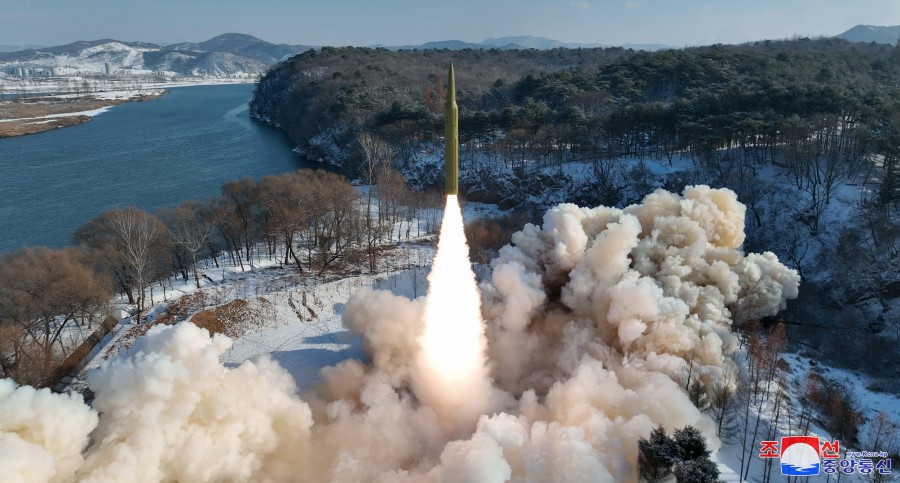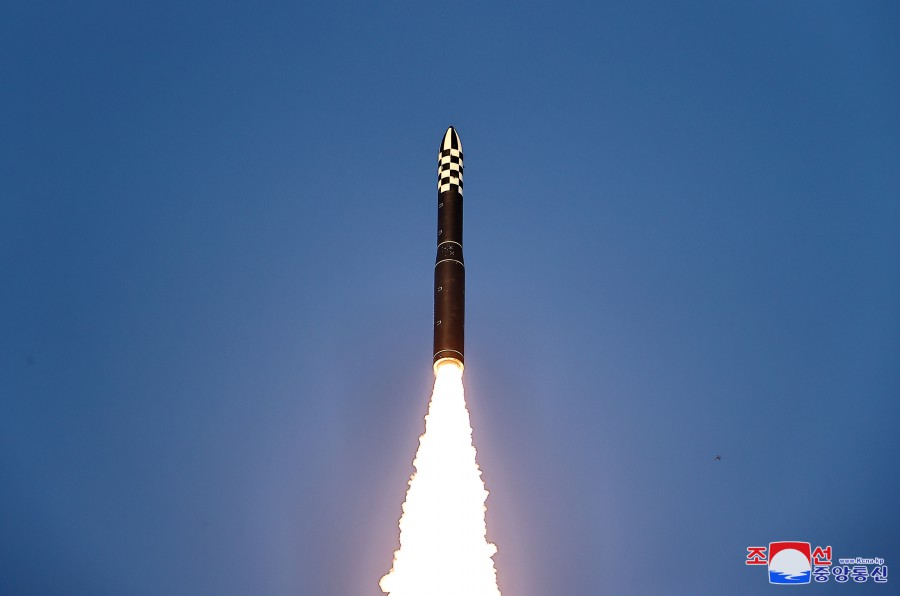North Korea Tests New Solid IRBM With MaRV Payload
On January 14, North Korea conducted the initial flight test of its first solid-propellant intermediate-range ballistic missile (IRBM). The missile apparently used the first two stages of the Hwasong (HS)-18, a three-stage, solid-propellant intercontinental ballistic missile (ICBM). Using booster stages that have already been developed for the HS-18 will expedite the development of this new missile. Based on past practice, it will likely be deployed after only one or two more flight tests.
The new missile carried a maneuvering reentry vehicle (MaRV) previously flown on smaller missiles in 2022, rather than a traditional reentry vehicle (RV). IRBM MaRVs, which can use their maneuverability to complicate missile defenses, make sense for Pyongyang, given ongoing US efforts to strengthen the missile defense of Guam, which is at least 3,300 kilometers (km) from North Korea. If the IRBM is intended for deployment with a traditional RV as well, it is highly likely that North Korea will flight test it in that configuration at least once.
It remains to be seen whether the solid IRBM will be produced and deployed in parallel with or instead of the current, liquid-propellant HS-12 IRBM, given the relatively limited number of targets North Korea presumably sees lying between medium (1,000-3,000 km) and ICBM (5,500+ km) ranges. If Pyongyang sees an extensive need to cover targets within medium range with solid missiles, it would be more cost-effective to develop a new medium-range missile based on the IRBM/HS-18’s first stage than to deploy more of the new IRBMs.
Given the niche role IRBMs probably fill in Pyongyang’s operational plans, adding a solid-propellant system would provide only a marginal improvement. Solid-propellant missiles are safer and easier to operate in the road-mobile deployments used by the liquid HS-12 and the new IRBM, but North Korea has some 35 years of successfully operating road-mobile liquid missiles. Using the same first and second stages for the HS-18 ICBM and the new IRBM could offer logistical advantages, but devoting stage production to IRBMs would come at the cost of HS-18 production.
Information to Date
South Korea announced a suspected IRBM had been launched by North Korea on January 14 from in or around Pyongyang that flew about 1,000 km. Japan reported that the missile flew to the northeast for at least 500 km at a maximum altitude of about 50 km, landing in the sea. The next day, North Korean media confirmed the “test-fire of an intermediate-range solid-fuel ballistic missile loaded with a hypersonic maneuverable controlled warhead,” reporting that the successful test “was aimed at verifying the gliding and maneuvering characteristics of intermediate-range hypersonic maneuverable controlled warhead and the reliability of newly developed multi-stage high-thrust solid-fuel engines.” An accompanying photograph depicted a two-stage solid-propellant missile in the early stages of flight, carrying a conical, finned payload.

Analysis
This is the initial flight test of North Korea’s first solid-propellant IRBM. Pyongyang had announced conducting static (ground) tests of the first- and second-stage rocket motors for a solid IRBM in November 2023, which was the first indication from North Korea that this system was in the works. The photo released by North Korea indicates that the new IRBM uses the first and second stages of the Hwasong (HS) -18 three-stage, solid-propellant ICBM.

The conical, finned payload appears to be the same as that flown on January 5 and 11, 2022 on a shortened, medium-range ballistic missile (MRBM) version of the HS-12 liquid-propellant IRBM. At that time, North Korea suggested development of the payload, which it termed a “hypersonic glide vehicle,” had been completed. That said, it is unclear how extensively the conical, finned payload has maneuvered in testing to date, including on January 14.
While technically “hypersonic,” since it reaches a maximum velocity exceeding Mach 5,[1] this payload is a maneuvering reentry vehicle (MaRV) rather than the wedge-shaped boost-glide vehicles (BGVs) used in Chinese, Russian and US “hypersonic missiles.”[2] North Korea apparently flight tested its first version of a MaRV in 2017 on a variant of the Scud short-range ballistic missile. MaRVs are less maneuverable and less technically demanding to develop than BGVs, which can maneuver more drastically, over a larger area, and for a longer portion of the missile’s flight than MaRVs.
Implications
Deployment likely to be soon. The possibility of an IRBM version of the HS-18 ICBM was flagged in 38 North in April 2023. The Soviets took the same path in the 1970s in using the first two stages of the original SS-16 solid-propellant, road-mobile ICBM to create the later SS-20 IRBM. Using booster stages that have already been developed for the HS-18 will expedite development of the new IRBM, which the North is likely to suggest has begun deployment after one or two more flight tests. IRBM-related motor- and flight testing will add to the North’s confidence in the reliability of the parent HS-18 (and vice-versa).
Complicates Guam missile defense. Initial testing of the new IRBM with a MaRV rather than a traditional reentry vehicle (RV) was a surprise. If the IRBM is also intended for deployment with a traditional RV, it is highly likely that North Korea will flight test it in that configuration at least once.
The key comparative advantage of the North Korean MaRV probably is in using its maneuverability to complicate missile defenses, and IRBM MaRVs make sense for Pyongyang given ongoing US efforts to strengthen the missile defense of US bases in Guam (at least 3,300 km from North Korea). North Korea also probably aspires to develop MaRVs equipped with terminal sensors that could maneuver the warhead to precisely hit its target, but it is unlikely to have that capability at IRBM ranges at present. Therefore, this could be one of many areas where technological assistance from Russia would be useful.
Add to or replace liquid IRBM production? It remains to be seen whether the solid IRBM will be produced and deployed in parallel with or instead of the liquid HS-12 IRBM. There are good reasons for North Korea to retain both solid and liquid strategic missiles, as it almost certainly is doing with ICBMs. But the relatively limited number of targets North Korea presumably sees lying between MRBM (1,000-3,000 km) and ICBM (5,500+ km) range—Guam, perhaps US bases in the Philippines and Midway, and possibly US missile defense radars in the Aleutians—may argue for concentrating on producing only one IRBM type. Pyongyang may, however, also see IRBMs as useful for covering targets within MRBM range, such as portions of Japan and Okinawa. If Pyongyang sees an extensive need to cover targets within medium range with solid missiles, it would be more cost-effective to develop a new MRBM based on the IRBM/HS-18’s first stage (which could also carry MaRVs) than to deploy more of the new IRBMs.
Only a marginal improvement. Given the niche role IRBMs probably fill in Pyongyang’s operational plans, adding a solid-propellant system would provide only a marginal improvement. Solid-propellant missiles are safer and easier to operate in the road-mobile deployments used by the liquid HS-12 and the new IRBM, but North Korea has some 35 years of successfully operating road-mobile liquid missiles. Using the same first and second stages for the HS-18 ICBM and the new IRBM could offer logistical advantages, but devoting stage production to IRBMs would come at the cost of HS-18 production.
- [1]
A traditional reentry vehicle delivered at IRBM ranges would exceed Mach 5 and, thus, technically also would be “hypersonic.”
- [2]
North Korea flight tested a BGV once in October 2021. It is unclear whether the test succeeded. See Vann H. Van Diepen, “Six Takeaways From North Korea’s “Hypersonic Missile” Announcement,” 38 North, October 13, 2021, https://www.38north.org/2021/10/six-takeaways-from-north-koreas-hypersonic-missile-announcement.
